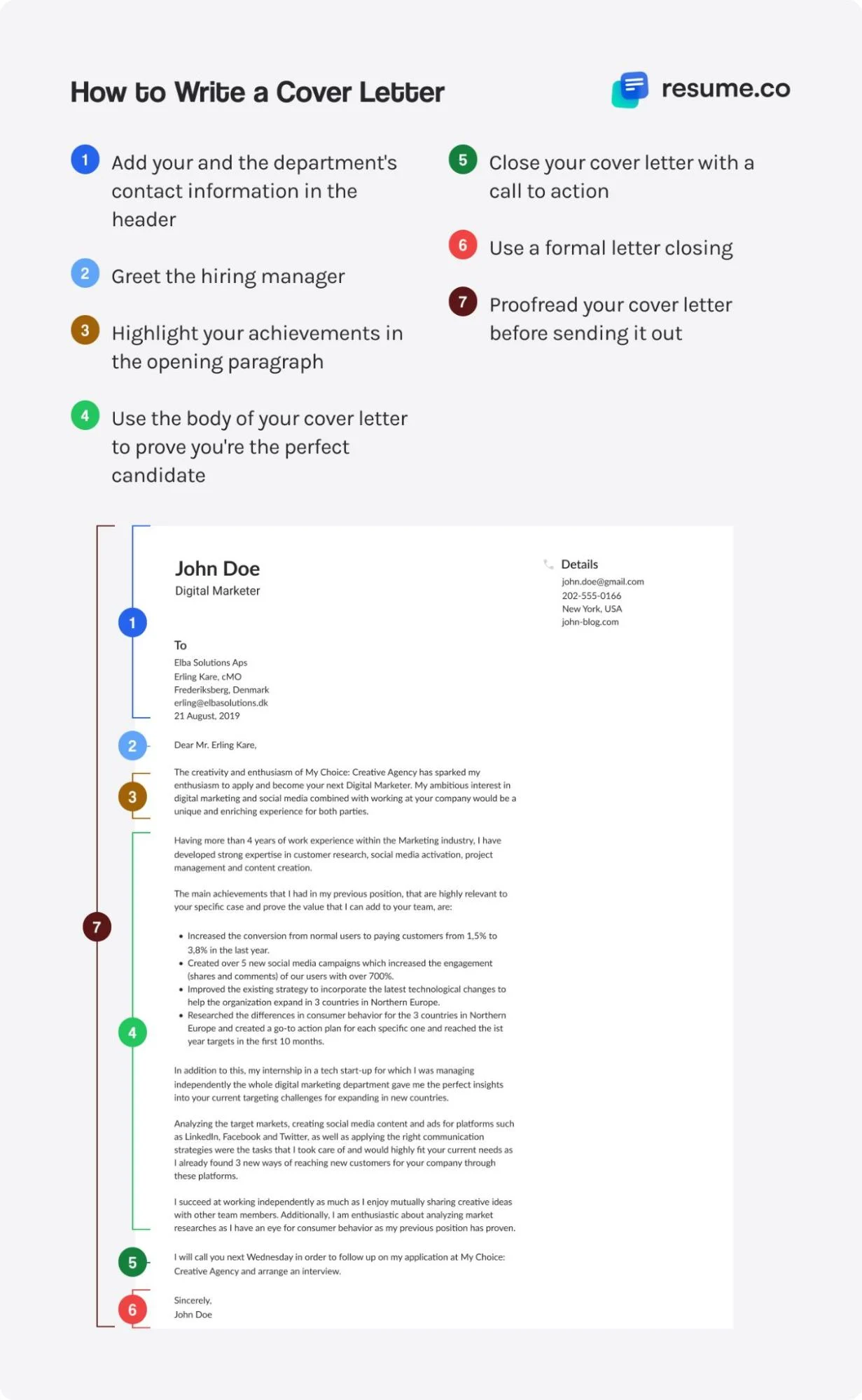An executive assistant cover letter is a document that helps you demonstrate your skills in supervising offices and organizations, impress hiring managers, and land job interviews. It combines with your resume to create an irresistible application package that highlights your passion and willingness to go the extra mile on top of your essential qualifications.
That’s why we created this comprehensive article to teach you how to write an executive assistant cover letter that grabs the reader’s attention. We’ll give you essential guidelines, pro tips, and expert examples to help you get ahead of the competition in the job-hunting race. Let’s dive in!
Key Takeaways
Your executive assistant cover letter should follow the business letter format.
For an optimal layout, your document should be one page long with a professional 10–12 pt font, single spacing, and one-inch margins.
An introductory paragraph should hook the reader with your biggest strengths.
A closing paragraph should have a call to action to suggest hiring managers call you over for an interview.
All the skills, experiences, and qualifications in your cover letter should be relevant to the role you’re after.
The Best Format for Executive Assistant Cover Letter
Business letter format is the one to use for your executive assistant cover letter. It’s a universal format that ensures your document conveys important information about your qualifications in a clear and concise manner.
Here’s how you should arrange the sections of your cover letter to follow this format:
Cover Letter Mandatory Sections
Contact information goes at the top, in the cover letter header.
A cordial greeting addresses the reader.
An introductory paragraph starts your letter with a catchy hook.
The main body should consist of 1–3 paragraphs of your skills, experiences, and motivations.
A closing paragraph should thank the reader and suggest further action, such as an interview.
A cordial ending statement with your sign-off completes the letter.
In addition to a cover letter format, you need a compelling layout to create a pleasant visual experience for the reader. Here are the guidelines on how you can achieve that:
Cover Letter Layout Guidelines
Your cover letter should be brief and condensed to one page.
The optimal length is 250–400 words and 3–5 paragraphs.
A professional cover letter font like Arial or Calibri will ensure a clean look and legibility.
Font size should be between 10 and 12 pt.
Uniform margins of at least 1 inch on all sides contribute to a polished look.
Line spacing of 1.0 or 1.15 with double that between paragraphs enhances readability.
If using all this information to create your cover letter from scratch seems daunting, you should try our cover letter builder. We designed an all-in-one software that combines professional executive assistant cover letter templates, endless customization options, and AI to help you craft an outstanding document in minutes.
What to Include in an Executive Assistant Cover Letter
Let’s find out what to include in an executive assistant cover letter by going through each of the sections. Before diving in, here’s a succinct visual guide to help you follow along:

#1. Heading
The heading is conventionally reserved for contact information. You should start with your details and list the following:
Heading Mandatory Details
Name
Job title
Phone number
Email address
Depending on role requirements, you can also include:
Heading Optional Details
Your address
LinkedIn
Relevant social media, website, or portfolio
On top of your contact information, you also want to include the recipient’s details along with the date and location of writing.
Here’s what that looks like in practice:
Heading Example
Elizabeth Hill Executive Assistant 588 Gorby Lane Jackson, MS 39201 601-326-9345 elizabethhill@example.com
Seattle, 07/05/2024
Beverly Rush Hiring Manager MNB Enterprises 1287 Raccoon Run Seattle, WA 98161
#2. Salutation
Salutation addresses the reader and helps introduce them to your executive assistant cover letter. This is a brief part of the document but an important one. The key is to address the recipient by their name, building rapport from the start and creating a personalized experience.
By researching the company before writing your cover letter, you’ll likely determine the name of the HR professional, supervisor, or employer who is going to read your letter. Mentioning them at the beginning of your letter shows that you went the extra mile to find this information.
Here’s an example:
Salutation Example
Dear Ms. Rush,
You want to avoid generic openings, like “Dear Sir or Madam” and “To Whom It May Concern.” If you can’t find the name of the recipient, you can always address them by their professional title, team, or department.
#3. Opening Paragraph
The opening paragraph is the elevator pitch for your executive assistant cover letter. It should grab the reader’s attention by highlighting your most impressive skills and accomplishments. You should also include the position you’re applying for and how many years of experience you have in the field.
Here’s a good example:
Opening Paragraph Example
I am excited to apply for the Executive Assistant position at MNB Enterprises, as advertised on your website. I have a Bachelor’s degree in Business Administration and more than five years of experience enhancing departmental efficiency by up to 25%. This, combined with my strong project management and organizational skills, makes me confident that I can contribute to your esteemed organization.
#4. Skills, Qualifications, & Experiences
The main purpose of your executive assistant cover letter is to demonstrate that you’re the right person for the job. To achieve this, you want to highlight all the relevant experiences, skills, and qualifications in the body of your cover letter.
Since we’ve already established that your letter should be concise, you want to go quality over quantity. Don’t list every hard and soft skill or job-related achievement that comes to mind, but only those that are related to the role.
If you’re writing an executive assistant cover letter with no experience, you should focus on your skills or academic accomplishments. On the other hand, experienced professionals should demonstrate their competence through past work achievements.
Let’s see a good example:
Skills, Qualifications, & Experiences Example
During my tenure at Horizon Solutions, I developed a robust document management system that helped reduce data retrieval times by 33%. Furthermore, I spearheaded an organization-wide transition to a state-of-the-art CRM system, which enhanced our interactions with clients and boosted satisfaction scores by 27%. I have also standardized processes and designed templates for the most common documents, reducing the menial administrative workload by 13%.
#5. Reasons for Applying
You should mention your reasons for applying to the company. That way, you can highlight your motivation and passion for the craft, which are valuable traits employers look for.
Moreover, by mentioning something specific, you demonstrate in-depth knowledge of the organization you want to join. That tells hiring managers you’ll likely be a good cultural fit and that you’ll get up to speed with their workflow quickly and efficiently.
Here’s an example:
Reasons for Applying Example
I’ve been following MNB Enterprises' work for years, and your commitment to innovation resonates with my professional goals. Your recent efforts to expand into new markets highlight an energetic and forward-thinking approach that aligns with my proactive attitude. I am eager to bring my problem-solving expertise to assist in your organization’s ongoing success.
#6. Call to Action
A call to action (CTA) used in the final paragraph is a powerful tool that can increase the chances of getting an invite for a job interview. You can also use it to draw attention to your resume. One of the best ways to include a CTA is after a thank-you note.
Here’s an example:
Call to Action Example
Thank you for your consideration. My resume, attached to this email, offers additional details about my qualifications. I’m enthusiastic about the opportunity to discuss over an interview how my experiences align with the role’s requirements and your company’s needs.
#7. Sign-Off
You should conclude your cover letter the same way you opened it: with a brief and polite statement. In a typical manner for business correspondence, you want to include a courteous and professional ending followed by your sign-off.
Let’s see that in an example:
Sign-Off Example
Sincerely, Elizabeth Hill
Here’s a comprehensive executive assistant cover letter example to help you understand everything that you’ve learned so far:
As we’re bringing this all-inclusive guide on executive assistant cover letters to a close, let's go through a couple of pro tips that will help elevate your document:
5 Pro Tips for Writing the Executive Assistant Cover Letter
Focus on your organizational skills. These abilities include everything from time management to delegation and are vital for executive assistants, so you want to ensure that you’ve mentioned them in your cover letter. For bonus points, you should use relevant achievements to demonstrate the actual results of your competence.
Don’t forget about your technical skills. Proficiency in relevant software and digital tools is a must for this job. That’s why you should include those programs and platforms that the role requires, whether it’s Microsoft Office Suite, Asana, Salesforce, or something else.
Use numbers and statistics when talking about your accomplishments. Quantify your work to make it concrete in the eyes of the reader. This significantly adds credibility to your competence and acts as solid proof of your skills.
Your cover letter should complement your executive assistant resume. That means you shouldn’t repeat the same information between the two documents but use additional space to talk about more of your executive assistant skills and experiences. Also, the layout of the two documents should match for a cohesive look.
Proofread your letter carefully before submitting it. A spotless document highlights accuracy, professionalism, and attention to detail. Even a simple typo can diminish the positive impact your cover letter has on hiring managers.
Final Thoughts
The median salary for executive assistants is $70,310. However, the salary varies based on your experience and goes from $37,890 for entry-level candidates to $91,330 for senior executive assistants. Another important metric to consider is the job outlook, which is in decline.
That’s why it’s more important than ever to go the extra mile and write a compelling executive assistant cover letter. By optimally highlighting your qualities and emphasizing your motivation, you’ll get ahead of the competition and significantly increase the chances of landing an interview.
When that happens, you’ll want to brush up on the most common executive assistant interview questions to maximize the odds of getting the job. Best of luck!
Related Articles
Office Assistant Resume Example & Writing Guide


